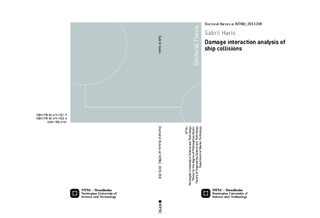| dc.description.abstract | During its lifetime, a ship may encounter accidents, such as collision and grounding, for which damage consequences in the forms of loss of human life, pollution of the environment, and economic losses may be substantial. This thesis focuses on the damage analysis of two deformable colliding ships using simplified analytical methods and numerical simulations.
In the simplified analytical methods, the ship structure is divided into several basic elements. Typical basic elements include the L‐section (angle), T‐section, Xsection (cruciform), web girder, and shell plating. The resistance of each basic element is evaluated, and all resistances are added to obtain the total response of the entire structure. Numerical simulations using the non‐linear finite element software LSDYNA 971 are conducted to provide virtual experimental data, especially when physical experiments are unavailable. Finite element analysis is also useful in observations of the contribution of each structural part to the total resistance.
A new formula to calculate the resistance of shell platings is proposed. Derivation of the formula is based on a kinematically admissible displacement field, which is obtained from observations of the characteristic deformation modes in physical experiments and numerical simulations. The shell plating is subjected to a rigid indenter, whose shape is modelled as an elliptical parabolic surface; the surface is parameterized by the curvatures α and β in the transverse and vertical direction. The elliptical parabolic surface is more suitable for idealizing the actual shape of the striking bow than the existing approach, which models the indenter as a sharp point or with a circular surface. By partitioning the plate girder intersection on a side structure of a ship, the effective width of the cruciform is determined. The contribution of the stiffeners to the resistance of their parent elements is also analysed. New formulae for determining the total resistance of a ship side struck by a rigid bow and a bow that has collided with a rigid wall are proposed. These formulae are utilized in the simplified analysis of a collision between two deformable ships.
Numerical simulations of right‐angle collisions between two real ships are performed for several collision scenarios. The finite element model, in which a fine mesh is applied in the vicinity of the collision area, consists of 660,000 elements. Three types of collision behaviour are identified: Collision Type 1—a relatively rigid bow striking a deformable ship side, Collision Type 2—a relatively rigid side colliding with a deformable bow, and Collision Type 3—a case in which both ships deform.
A new simplified procedure for analysing a right‐angle ship‐ship collision is proposed. Calculation of the resistance of each ship is based on the proposed formulae; their values are subsequently compared to identify the type of collision that will occur. For Collision Types 1 and 2, in which the resistance of one ship is relatively dominant to the resistance of the other ship, the analysis is simplified to a collision between a rigid structure and a deformable ship. Otherwise, a damage interaction analysis between two deformable ships should be conducted (Collision Type 3). During the collision process, the structural damage may switch between the two ships. Updating curvatures α and β of the bow shape due to the damage of the ships is a unique step in this new procedure. The predicted contact force and the internal energy dissipated during the collision demonstrate good agreement with the reference data provided by the numerical simulations. | nb_NO |
